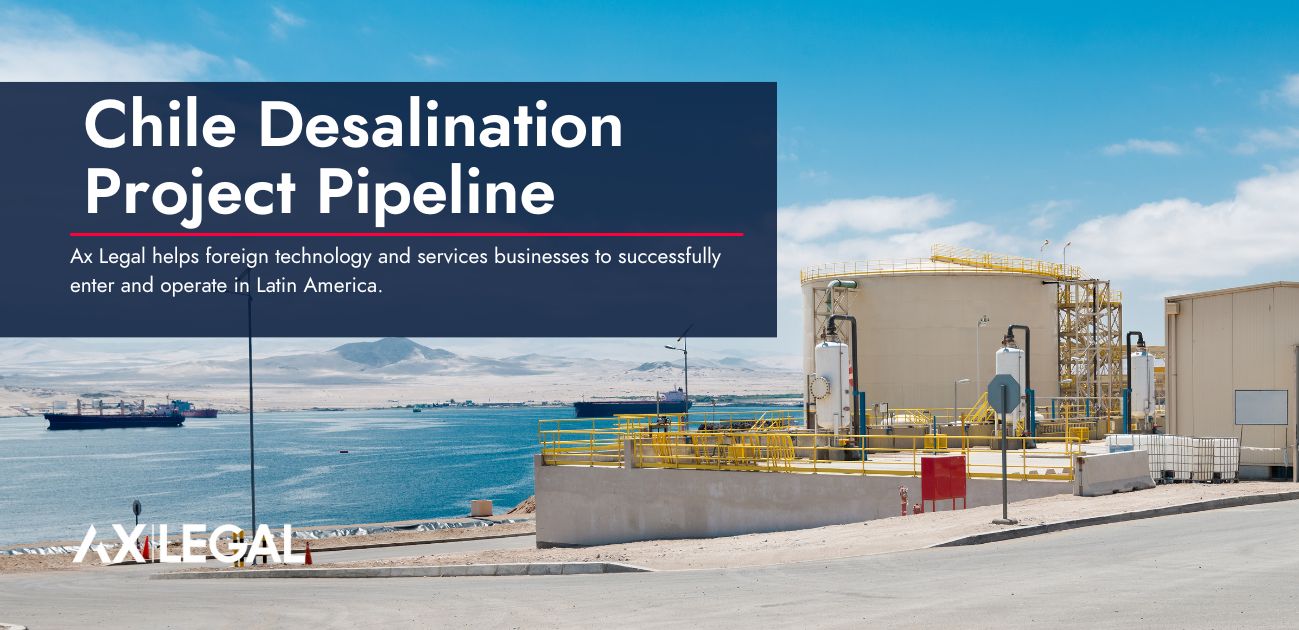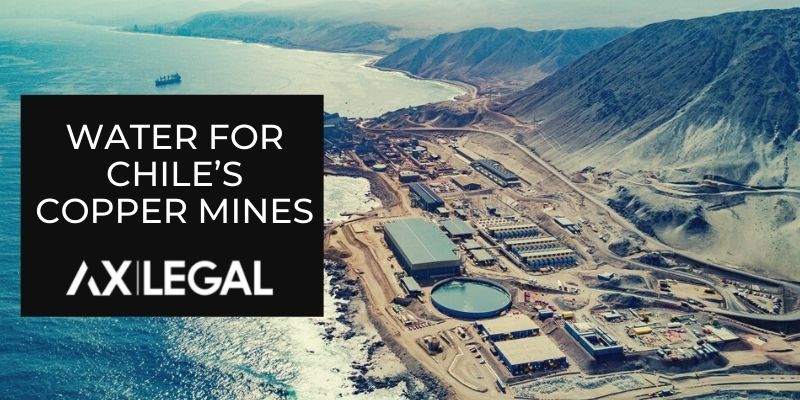Chile Desalination Project Pipeline
You do not have to look far to seeing the changing climate patterns across Chile. The country has faced a decade-long drought that has impacted local communities and whole industries alike. According to the environment ministry, 73% of the country’s water is used for agriculture, while industry consumes 12%, mining consumes 9%, and the population only 6%.
Although the mining industry only uses 9% of the countries water, it has been the most proactive in terms of reusing water in its operations and utilizing desalination to feed its massive copper mines. There has been such a large push by the miners to not use continental water in their operations that it helped kick-start the desalination industry in Chile.
According to a report published earlier in the year by the Chilean Desalination Association (Acades), the country already has 22 plants in operation, six under construction, 3 that have received environmental approval, and 12 at the preliminary assessment stage.
The authors of the report found that the facilities currently in operations have a combined capacity of 8,200 liters per second and 75% of that is already going to the mining industry. It is projected that this will rise to 25,000 liters per second if all the projects materialize between now and 2028.
Although the mining industry will continue to drive growth of new desalination capacity, there are new opportunities that will see desalinated water being used for human consumption and agriculture. We take a closer look at the project pipeline for desalination plants.
Desalination for Mining – Currently Operating
Currently, the mining industry has the following desalination plants in operation –
- Escondida Mine – 2,500 l/s
- Escondida Coloso Plant – 525 l/s
- Spence Mine – 1000 l/s
- Cap Minera – 600 l/s
- Lundin Mining – 500 l/s
- Capstone – 120 l/s
Desalination / Seawater for Mining – Project Pipeline until 2025 |
||
| 2023 | Quebrada Blanca 2: |
The 850 l/s desalination plant came online earlier this year. The plant can be increased to 1200 l/s in the future when required. It was designed and supplied by IDE Technologies. |
| 2023 | INCO: |
Antofagasta Minerals built the 400l/s desalination plants for its Los Pelambres copper mine. The water will be stored in a 1,000m3 tank and then pumped through a 61km, 24″ diameter pipeline to the El Mauro industrial area before going to the mine site. |
| 2024 | Mantoverde Development: |
Captone is doubling the capacity of its existing plant to 260 l/s which will supply water to its expansion project that is expected to come online in 2024. |
| 2024 | Centinela Mine Development: |
Although not a desalination plant, Antofagasta minerals will use seawater to supply Centinela with water for its operations using a new 1,150l/s pipeline that is being built. |
| 2024 | Sierra Norte: |
Although not a desalination plant, the mine will be supplied with 315l/s seawater that will be transported through a 60km pipeline to the Sierra Norte Project. |
| 2025 | Distrito Norte: |
Codelco will build a USD$1b desalination plant to supply its northern district mines. The plant will have an initial design capacity of 840 l/s, with expansion potential to 1,956 l/s. The desalinated water will be pumped through a 160 kilometers pipeline. |
| 2025 | Collahuasi: |
Glencore and Anglo American will build a desalination plant with an initial capacity of approx. 525l/s and that will be expanded to 1,050l/s |
| 2025 | Candelaria: | Lundin Mining plans to add 100l/s to the existing capacity at the desalination facilities serving its Candelaria mine. |
| 2025 | Santo Domingo: |
Capstone is evaluating the construction of a 480l/s desalination plant for its greenfield US$2.2 billion Santo Domingo project. It is also evaluating expanding its Mantoverde desalination plant to 840l/s to serve both mines. |
Municipal Desalination – Project Pipeline |
|
| Coquimbo Desalination Plant |
One of the first desalination concessions that the government’s plan to tender is the US$286m project that will supply the Coquimbo region. The plant is of high priority due to the region scarcity of water. It will have a capacity of1,700 l/s that is intended for human and agricultural consumption. It is expected to be tendered by 2025. |
| Rancagua Desalination Plant |
The second project that is expected to be a concession by the government with a cost of USD$186m. The projects consist of a 900l/s plant that will serve industrial, agricultural, and human consumption. |
| Aconcagua desalination project |
The USD$1b desalination plant will have a capacity of 1,000l/s. Water will then be transported via a 105km aqueduct to five distribution centers located in the Aconcagua valley. The project aims to supply half of its output to Los Bronces mine starting in 2025. |
| Aguas Marítimas |
The USD$5b desalination plant will have a capacity of 8,100l/s. Water will be used to serve Antofagasta, Sierra Gorda, and Calama. Albemarle has also signed a supply agreement for its lithium assets. |
| Enapac |
The USD$1.5b desalination plant will have a capacity of 2,630l/s that will be powered by a 150MW photovoltaic plant, and have a 600,000m3 reservoir. The project will have 2 distribution pipelines. The first will involves a 166km underground pipeline between the municipalities of Copiapó and Diego de Almagro. The second involves a 197km pipeline that would transport up to 1,200l/s of desalinated water to Copiapó, where the water would be sold to industrial and mining customers, including lithium operations in the Salar de Maricunga. |
Conclusion
Chile has the largest desalination capacity and project pipeline for all Latin America. The mining industry has been investing significantly over the last 10 years which has kick started the industry and supported it until now. Now the country is seeing interest from municipalities and other industries such as agriculture. with the first concessions for a desalination plant to be tendered by the government.
Mining operations are going to continue to need water, particularly as ore grades degrade and more material needs to be processed to recover the same amount of copper.
There are some particularly important areas where mining companies will need to focus if they will lower the environmental footprint and costs associated with building out desalination plants.
- Shared Infrastructure – Due to the cost of building out the infrastructure, it will be important for companies to find opportunities where they can share water infrastructure (pipelines, powerlines) to lower both capital and operating costs. The addition of seawater desalination to a large-scale project adds at least a billion dollars to project capex. Escondida spent more than $3 billion for a massive plant that desalinates 2,500 litres per second (lps) in 2018. Sharing infrastructure will be more cost efficient.
- Water Recycling – Companies have already taken large steps to recycle as much of their current water as possible. More can be done in this aspect and technology will play a part in reducing the water needed in processing, reusing water from tailings, and reducing the general water usage across mine sites (ex. water used on haul roads to reduce dust).
- Energy Usage – Desalination plants and the pumping stations used to move the water to the mine sites are extremely energy intensive. Fortunately, Northern Chile has some of the best renewable capacity in the world and it will be extremely important that companies tap into this energy to lower their energy costs and reduce the need of carbon-based energy sources to power their infrastructure needed to move the water to site.
- Environmental and Social License – Desalination plants are going to be put pressure on the marine ecosystem. It will be important for companies to monitor their brine discharge and ensure that are no long-term consequences on the environment. They will also need to partner with local communities, so they also benefit and have access to water through the existing infrastructure.
Ax Legal is an advisory firm that works with foreign companies in Latin America. Our team of legal and commercial advisors have a distinguished track record of helping foreign technology and services companies to grow and operate in Latin America. Over the years, we have worked with starts up, mid-size businesses, and publicly listed companies. The one common factor that connects are clients is that they are leaders in their field, providing innovative technologies and services to the industrial sectors.
To better understand how we can support you in the Region, please contact Cody Mcfarlane at cmm@ax.legal




 Santiago
Santiago Sydney
Sydney Lima
Lima